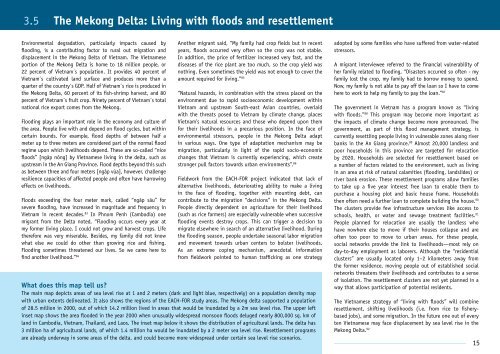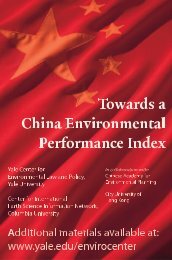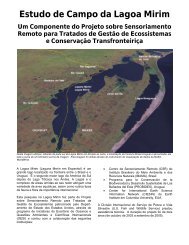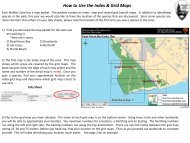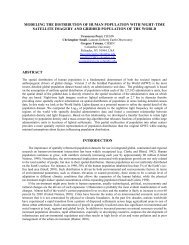In Search of Shelter - Center for International Earth Science ...
In Search of Shelter - Center for International Earth Science ...
In Search of Shelter - Center for International Earth Science ...
Create successful ePaper yourself
Turn your PDF publications into a flip-book with our unique Google optimized e-Paper software.
3.5 The Mekong Delta: Living with floods and resettlementEnvironmental degradation, particularly impacts caused byflooding, is a contributing factor to rural out migration anddisplacement in the Mekong Delta <strong>of</strong> Vietnam. The Vietnameseportion <strong>of</strong> the Mekong Delta is home to 18 million people, or22 percent <strong>of</strong> Vietnam´s population. It provides 40 percent <strong>of</strong>Vietnam´s cultivated land surface and produces more than aquarter <strong>of</strong> the country´s GDP. Half <strong>of</strong> Vietnam´s rice is produced inthe Mekong Delta, 60 percent <strong>of</strong> its fish-shrimp harvest, and 80percent <strong>of</strong> Vietnam´s fruit crop. Ninety percent <strong>of</strong> Vietnam´s totalnational rice export comes from the Mekong.Flooding plays an important role in the economy and culture <strong>of</strong>the area. People live with and depend on flood cycles, but withincertain bounds. For example, flood depths <strong>of</strong> between half ameter up to three meters are considered part <strong>of</strong> the normal floodregime upon which livelihoods depend. These are so-called “nicefloods” [ngâp nông] by Vietnamese living in the delta, such asupstream in the An Giang Province. Flood depths beyond this suchas between three and four meters [ngâp vùa], however, challengeresilience capacities <strong>of</strong> affected people and <strong>of</strong>ten have harrowingeffects on livelihoods.Floods exceeding the four meter mark, called “ngâp sâu” <strong>for</strong>severe flooding, have increased in magnitude and frequency inVietnam in recent decades. 83 <strong>In</strong> Phnom Penh (Cambodia) onemigrant from the Delta noted, “Flooding occurs every year atmy <strong>for</strong>mer living place. I could not grow and harvest crops. Lifethere<strong>for</strong>e was very miserable. Besides, my family did not knowwhat else we could do other than growing rice and fishing.Flooding sometimes threatened our lives. So we came here t<strong>of</strong>ind another livelihood.” 84Another migrant said, “My family had crop fields but in recentyears, floods occurred very <strong>of</strong>ten so the crop was not stable.<strong>In</strong> addition, the price <strong>of</strong> fertilizer increased very fast, and thediseases <strong>of</strong> the rice plant are too much, so the crop yield wasnothing. Even sometimes the yield was not enough to cover theamount required <strong>for</strong> living.” 85“Natural hazards, in combination with the stress placed on theenvironment due to rapid socioeconomic development withinVietnam and upstream South-east Asian countries, overlaidwith the threats posed to Vietnam by climate change, placesVietnam’s natural resources and those who depend upon them<strong>for</strong> their livelihoods in a precarious position. <strong>In</strong> the face <strong>of</strong>environmental stressors, people in the Mekong Delta adaptin various ways. One type <strong>of</strong> adaptation mechanism may bemigration, particularly in light <strong>of</strong> the rapid socio-economicchanges that Vietnam is currently experiencing, which createstronger pull factors towards urban environments”. 86Fieldwork from the EACH-FOR project indicated that lack <strong>of</strong>alternative livelihoods, deteriorating ability to make a livingin the face <strong>of</strong> flooding, together with mounting debt, cancontribute to the migration “decisions” in the Mekong Delta.People directly dependent on agriculture <strong>for</strong> their livelihood(such as rice farmers) are especially vulnerable when successiveflooding events destroy crops. This can trigger a decision tomigrate elsewhere in search <strong>of</strong> an alternative livelihood. Duringthe flooding season, people undertake seasonal labor migrationand movement towards urban centers to bolster livelihoods.As an extreme coping mechanism, anecdotal in<strong>for</strong>mationfrom fieldwork pointed to human trafficking as one strategyWhat does this map tell us?The main map depicts areas <strong>of</strong> sea level rise at 1 and 2 meters (dark and light blue, respectively) on a population density mapwith urban extents delineated. It also shows the regions <strong>of</strong> the EACH-FOR study areas. The Mekong delta supported a population<strong>of</strong> 28.5 million in 2000, out <strong>of</strong> which 14.2 million lived in areas that would be inundated by a 2m sea level rise. The upper leftinset map shows the area flooded in the year 2000 when unusually widespread monsoon floods deluged nearly 800,000 sq. km <strong>of</strong>land in Cambodia, Vietnam, Thailand, and Laos. The inset map below it shows the distribution <strong>of</strong> agricultural lands. The delta has3 million ha <strong>of</strong> agricultural lands, <strong>of</strong> which 1.4 million ha would be inundated by a 2 meter sea level rise. Resettlement programsare already underway in some areas <strong>of</strong> the delta, and could become more widespread under certain sea level rise scenarios.adopted by some families who have suffered from water-relatedstressors.A migrant interviewee referred to the financial vulnerability <strong>of</strong>her family related to flooding, “Disasters occurred so <strong>of</strong>ten - myfamily lost the crop, my family had to borrow money to spend.Now, my family is not able to pay <strong>of</strong>f the loan so I have to comehere to work to help my family to pay the loan.” 87The government in Vietnam has a program known as “livingwith floods.” 88 This program may become more important asthe impacts <strong>of</strong> climate change become more pronounced. Thegovernment, as part <strong>of</strong> this flood management strategy, iscurrently resettling people living in vulnerable zones along riverbanks in the An Giang province. 89 Almost 20,000 landless andpoor households in this province are targeted <strong>for</strong> relocationby 2020. Households are selected <strong>for</strong> resettlement based ona number <strong>of</strong> factors related to the environment, such as livingin an area at risk <strong>of</strong> natural calamities (flooding, landslides) orriver bank erosion. These resettlement programs allow familiesto take up a five year interest free loan to enable them topurchase a housing plot and basic house frame. Householdsthen <strong>of</strong>ten need a further loan to complete building the house. 90The clusters provide few infrastructure services like access toschools, health, or water and sewage treatment facilities. 91People planned <strong>for</strong> relocation are usually the landless whohave nowhere else to move if their houses collapse and are<strong>of</strong>ten too poor to move to urban areas. For these people,social networks provide the link to livelihoods—most rely onday-to-day employment as laborers. Although the “residentialclusters” are usually located only 1–2 kilometers away fromthe <strong>for</strong>mer residence, moving people out <strong>of</strong> established socialnetworks threatens their livelihoods and contributes to a sense<strong>of</strong> isolation. The resettlement clusters are not yet planned in away that allows participation <strong>of</strong> potential residents.The Vietnamese strategy <strong>of</strong> “living with floods” will combineresettlement, shifting livelihoods (i.e. from rice to fisherybasedjobs), and some migration. <strong>In</strong> the future one out <strong>of</strong> everyten Vietnamese may face displacement by sea level rise in theMekong Delta. 9215


